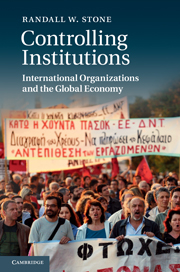Book contents
- Frontmatter
- Contents
- List of figures
- List of tables
- Preface
- List of abbreviations
- 1 Introduction: international organization and US power
- PART ONE THEORY
- PART TWO CASES
- PART THREE HYPOTHESES
- 7 Access to IMF resources
- 8 Conditionality under IMF programs
- 9 Enforcement
- 10 Conclusions
- Appendix: additional tables
- References
- Index
8 - Conditionality under IMF programs
Published online by Cambridge University Press: 11 April 2011
- Frontmatter
- Contents
- List of figures
- List of tables
- Preface
- List of abbreviations
- 1 Introduction: international organization and US power
- PART ONE THEORY
- PART TWO CASES
- PART THREE HYPOTHESES
- 7 Access to IMF resources
- 8 Conditionality under IMF programs
- 9 Enforcement
- 10 Conclusions
- Appendix: additional tables
- References
- Index
Summary
Conditionality, the practice of requiring policy reform as a condition for receiving IMF support, is not stipulated in the IMF's Articles of Agreement and was originally instituted at the insistence of the United States and over the objections of the rest of the membership. After the collapse of the Bretton Woods system of fixed exchange rates the Fund reinvented itself as an agency with extensive involvement in the politics of development, and a broad consensus emerged on the Executive Board that managing conditionality should become a more important part of its mandate. As late as the 1970s, only 26 percent of IMF loan disbursements involved substantial conditionality, but the Latin American debt crisis in the 1980s and the expansion of lending to Africa increased this figure to 66 percent by the end of the 1980s. The number of conditions specified in an IMF program steadily climbed in the subsequent decade as the Fund sought to manage the transition from state planning to the market in former Communist countries and grappled with financial sector issues in the East Asian crisis. At the same time, the scope of conditionality ventured into areas of domestic economic structure and policies outside the Fund's traditional purview and competence.
The Executive Board does not play a direct role in designing the conditionality in individual programs. As a practical matter, by the time a program reaches the board it has been thoroughly analyzed by the staff, negotiated with the authorities of the borrowing member country, and approved by management and the shareholders that choose to participate.
- Type
- Chapter
- Information
- Controlling InstitutionsInternational Organizations and the Global Economy, pp. 154 - 178Publisher: Cambridge University PressPrint publication year: 2011



